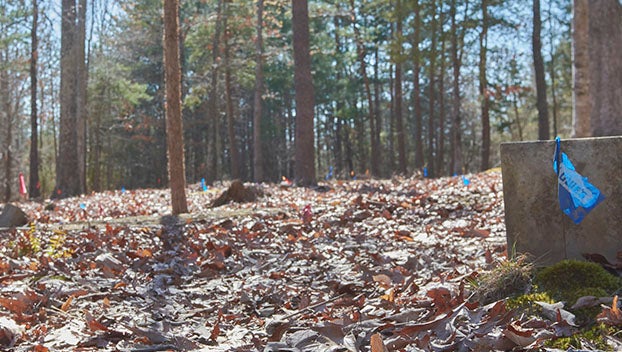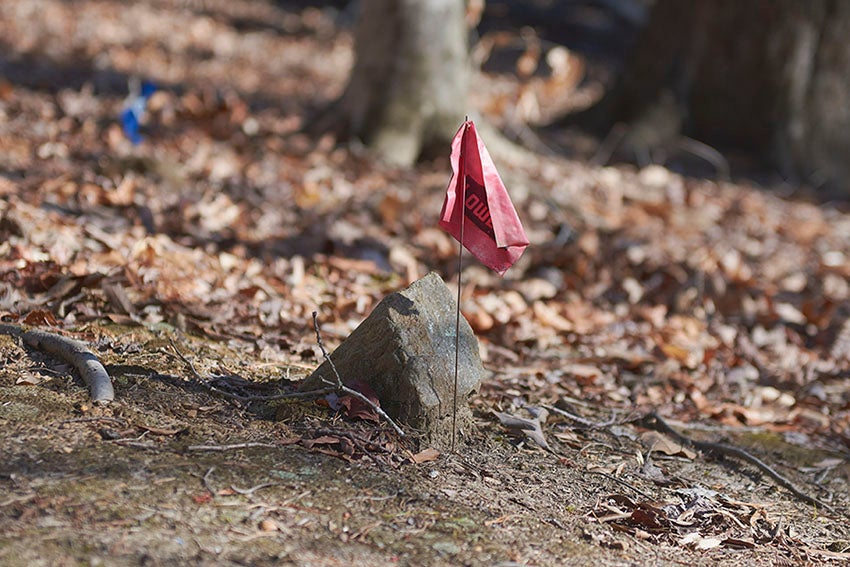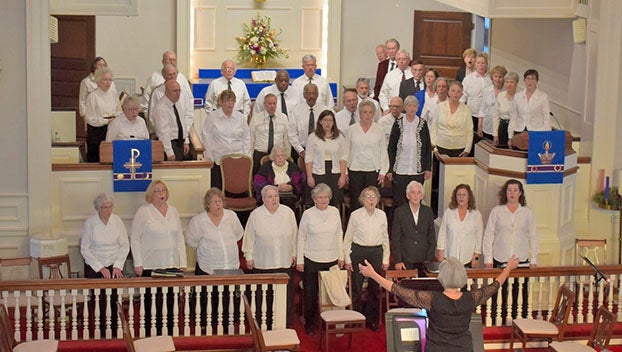Small graves mark a big mystery at High Bridge Trail State Park
Published 11:45 am Sunday, March 26, 2023

- (CONNOR THOMPSON | HERALD) Marker flag stuck in the ground next to suspected grave sites.
|
Getting your Trinity Audio player ready...
|
On a warm July day in 1906, an African-American man was struck by a train in Rice. The Farmville Herald wrote in their July 20, 1906 issue that he “was brought to Farmville, where he lingered for a few hours and died in great agony.” There was no obituary to be found for the man, a 65 year-old “respected colored man,” the newspaper wrote of Mr. Henry Jeter. His life may have ended in the early 20th century, but his name is the first piece of a puzzle High Bridge Trail State Park has been trying to piece together for years.
“We just don’t have much information on it,” said Daniel Jordan, the park’s manager.
Recently, blue and red flags have been spotted at the back side of Camp Paradise’s parking lot. Daniel says they mark the head and footstones of each grave, and right now, they’ve discovered 67 burial sites.
“Most are marked with plain stones at the head and the foot, and so we believe it’s a community cemetery,” Jordan said.
Discovering a cemetery
In 2010, when the state’s Department of Conservation and Recreation purchased the property to expand the parking lot and access road at Camp Paradise, they discovered there was a cemetery in that purchase. At that time, Jordan says staff was working diligently to check boundary lines and marking them, to ensure they were maintained.
“The park has reclaimed the cemetery as far as cleaning out the underbrush and cutting out small trees,” he said.
But it’s been nearly impossible to identify the graves. In fact, the only stone that was marked with a name was that of Mr. Jeter.
“On the 12th instant, Henry Jeter, a respected colored man about 65 years old, living near Rice, while he was talking to an N. and W. Fireman, Mr. Raikes, failed to notice an approaching locomotive, and was struck in the side, so as to injure the lungs,” The Herald article from 1906 reads. “He was brought to Farmville, where he lingered for a few hours and died in great agony.”
Jordan says he was told years ago that Jeter possibly was connected to the Moton family. But beyond that, it’s been tough to fill in the blanks.
“We know the cemetery probably dates back to the mid-1800s,” he said. “There’s some very small graves in there, so we believe children are buried there too.
Theories abound at High Bridge Trail State Park
There’s a couple different theories on whether it was a community cemetery, or if it was workmen who were killed on the railway when they were building the bridge.”
The park has been working with Longwood Archaeology and the Department of Historic Resources to figure out the property’s significance, but they also want to do right by those buried there, and they’re hoping the public might have the insight.
“With it being late 1800s, early 1900s, the hope would be ‘oh, my great-great grandfather is buried there,’ just to learn more from community conversations would be great,” Jordan said. “We’d love to know more of the story and if anyone in the public knows anything, we’d greatly enjoy having that conversation, because we want to learn who is buried here and how we can best honor their legacy.”






